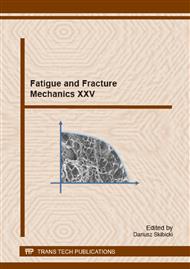[1]
Standards PN-EN 12952-3: 2001, (2001).
Google Scholar
[2]
J. Okrajni, Thermo-mechanical fatigue conditions of power plant components. Journal of Achievements in Materials and Manufacturing Engineering 33 (2009) 53-61.
Google Scholar
[3]
J. Okrajni, M. Twardawa, Boundary conditions in models of power plant components under thermal loading, Archieve of Materials Science and Engineering 62, Iss. 1 ( 2013) 28-35.
Google Scholar
[4]
J. Okrajni, M. Twardawa, Influence of a variable in time heat transfer coefficient on stresses in model of power plant components, J. Pressure Vessel Technol. 136(4), 041602 (Apr 15, 2014) (6 pages).
DOI: 10.1115/1.4026799
Google Scholar
[5]
Z. Orłoś (ed. ), Thermal stresses, PWN, Warsaw, 1991 (in Polish).
Google Scholar
[6]
T. P. Farragher, S. Scully, N. P. O'Dowd, S. B. Leen, Development of life assessment procedures for power plant headers operated under flexible loading scenarios. International Journal of Fatigue 49 (2013) 50–61.
DOI: 10.1016/j.ijfatigue.2012.12.007
Google Scholar
[7]
J. Bressers, L. Remy (eds. ), Fatigue under Thermal and Mechanical loading, Kluwer Academic Publishers, Netherlands, (1996).
Google Scholar
[8]
P. Hähner, C. Rinaldi, V. Bicego, E. Affeld, T. Brendel, H. Andersson, T. Beck, H. Klingelhöffer, H-J Kühn, A. Köster, M. Laveday, M. Marchionni, C. Rae, Research and development into a European code-of-practice for strain-controlled thermo-mechanical fatigue test. International Journal of Fatigue 30 (2008).
DOI: 10.1016/j.ijfatigue.2007.01.052
Google Scholar
[9]
J. Okrajni, G. Junak, A. Marek, Modelling of the deformation process under thermo-mechanical fatigue conditions. International Journal of Fatigue 30, No. 2 (2008) 324-329.
DOI: 10.1016/j.ijfatigue.2007.01.043
Google Scholar
[10]
J. Okrajni, M. Plaza, Simulation of the fracture process of materials subjected to low-cycle fatigue of mechanical and thermal character. Journal of Material Processing Technology 53 (1995) 311- 318.
DOI: 10.1016/0924-0136(95)01988-q
Google Scholar
[11]
A. Marek, J. Okrajni, Local stress-strain behaviour of high-temperature steam valve under transient mechanical and thermal loading, Journal of Materials Engineering and Performance, 23, 1 (2014) 31-38.
DOI: 10.1007/s11665-013-0744-3
Google Scholar
[12]
J. Okrajni, M. Cieśla, L. Swadźba, High-temperature low-cycle fatigue and creep behaviour of nickel-based superalloys with heat-resistant coatings, Fatigue & Fracure of Engineering Materials and Structures, 21, 8 (1998) 947-954.
DOI: 10.1046/j.1460-2695.1998.00090.x
Google Scholar
[13]
S. Mroziński, G. Golański, Influence of temperature change on fatigue properties of P91 steel, Material Research Innovations, 18, 2 (2014) 504-508.
DOI: 10.1179/1432891714z.000000000546
Google Scholar


